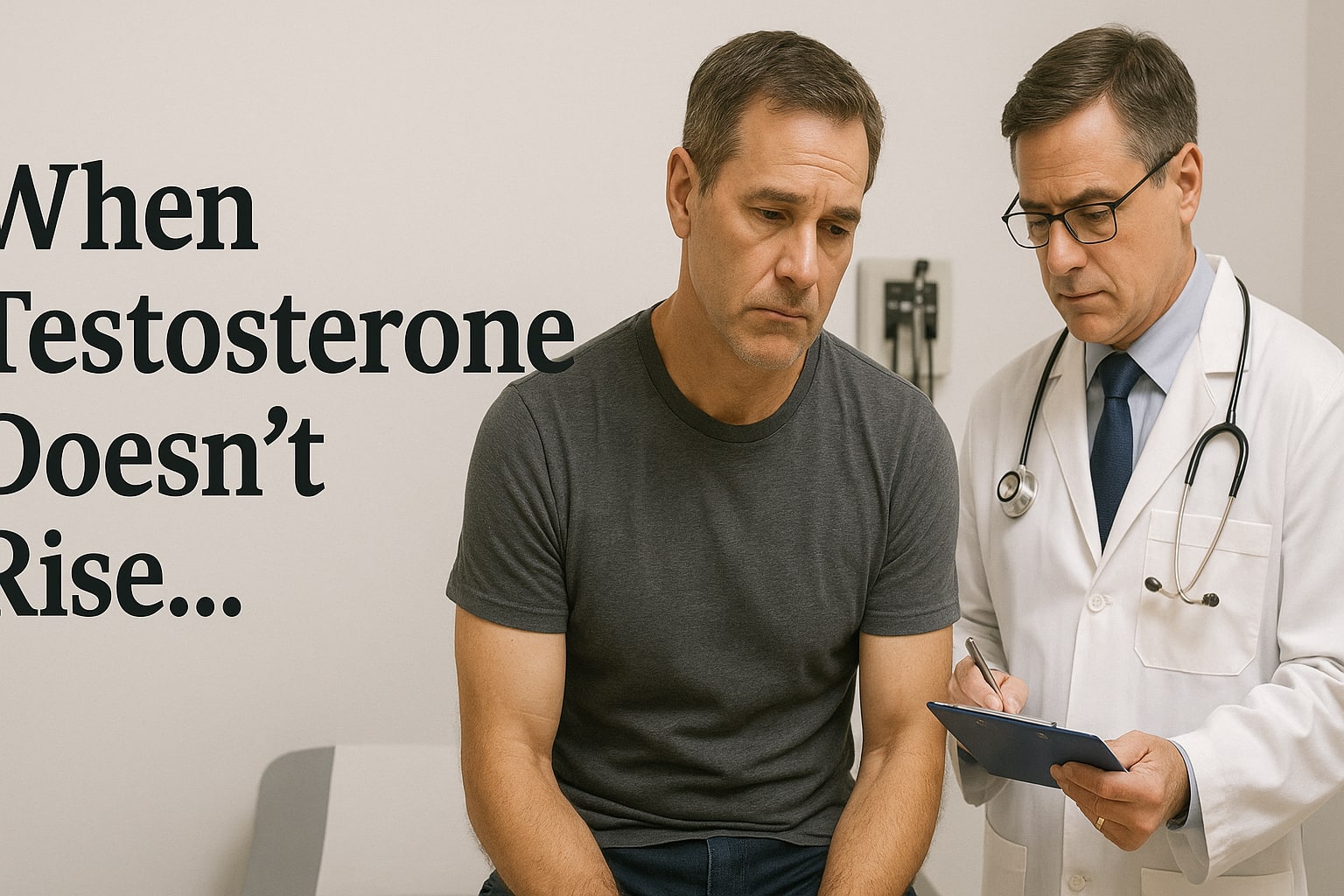When Testosterone Doesn’t Rise (or work): What You Might Be Missing


After nearly two decades in compounding pharmacy—much of it spent helping patients navigate hormone replacement therapy—I’ve often heard that treating men is “easier” than managing women’s hormones. But in reality, testosterone therapy can be surprisingly complex.
When things don’t go as planned, the pharmacy is usually the first to be blamed. I can’t count how many times I’ve heard, “The testosterone cream isn’t working.” Often, the concern isn’t with the cream, but rather a sign that there may be an underlying issue worth exploring.
Let me show you some of the recurring patterns and valuable lessons I’ve uncovered in practice.
First, as we all know, labs are merely a snapshot in time. Hormone messengers are constantly in flux, spinning from one hormone metabolite to another. Therefore, making sure that we are measuring a comprehensive set of labs is important for getting a full picture of what’s going on.
For hormone assessment, LH, FSH, Total Testosterone, Albumin, SHBG, Estradiol, DHEA-S and DHT should be considered standard. You’ll notice that we didn’t mention Free Testosterone. That’s because you can simply plug in Albumin, Total Testosterone and SHBG into an online calculator (http://www.issam.ch/freetesto.htm) to grab that result. The calculator will also provide you with something called bioavailable testosterone, an assessment of how much testosterone is available for the body to access at any given time. The optimal range for bioavailable testosterone may be between 300-500ng/dl.
Second, consider that lab errors are more common than you may realize, and lab measurements can vary from one company to another. If it doesn’t make sense, make sure to repeat the lab test.
Third, make sure that your patient's symptoms correlate with the labs. If he feels great, and the labs came out low, then there is probably something amiss.
Fourth, consider timing. Measuring testosterone 24 hours after application may capture a trough level, especially in patients who metabolize it efficiently. With a half-life ranging from 8 to 22 hours, only about 12.5% of the dose may remain after three half-lives—roughly one day later. To assess absorption, aim to measure levels 2–4 hours after morning application. If levels are rising appropriately, that’s a good sign—but it may also suggest the patient will benefit from twice-daily dosing to maintain therapeutic levels.
Fifth, consider non-compliance. I hate to say it, but we often forget to apply our hormones and take our meds.
With sufficient testosterone replacement, both LH and FSH levels should come down. If they are both trending downwards, then it's most likely that the testosterone is being absorbed, and metabolites should be considered.
There is a caveat, however, when low LH and FSH are accompanied with low testosterone levels. There may be some cause for concern for a pituitary adenoma or prolactinoma, concussion, traumatic brain injury, or cranial trauma which may need to be ruled out. Various medications such as statins, beta-blockers, alpha blockers, diuretics, opioids, chemotherapy, antidepressants, and illicit drugs can also cause the same effect.
Estradiol plays a critical role in cardiovascular health, offering both cardioprotective and vasoprotective benefits. But how much is too little—and how much is too much?
In the world of testosterone therapy, I’ve heard a wide range of opinions. Some experts don’t express concern until estradiol levels exceed 50 pg/mL. Others set that threshold closer to 60 pg/mL. Personally, I find this approach concerning—especially in older men, where elevated estradiol has been associated with an increased risk of stroke.1
One study on men with heart failure found that those with estradiol levels above 37.4 pg/mL had significantly higher mortality rates compared to men with mid-range (balanced quintile) levels. On the other end of the spectrum, men with estradiol below 12.9 pg/mL had a 317% increase in mortality versus the balanced group.2
Finding the right balance—not too high, not too low—may be more critical than many realize.
To help reduce excess estradiol, start by addressing key lifestyle factors—often the most effective first step in blunting aromatase activity. If those changes aren’t enough to bring estradiol below 35 pg/mL, targeted supplements or medications may be warranted. Personally, I believe every man on testosterone therapy should be taking zinc, as it plays a valuable role in supporting healthy estrogen metabolism.
Approximately 70% of testosterone is bound with high affinity to SHBG, and SHBG increases 1% per year in men, lowering bioavailable testosterone levels. SHBG levels may also be elevated in obese men with high levels of estradiol.
To maintain optimal levels of SHBG between 25-30pmol/L, freeze dried stinging nettles 2-4 g twice daily may competitively bind to SHBG, releasing both testosterone and DHT.
DHT is another common metabolite produced from testosterone, and its concentration depends on the amount of testosterone present. Therefore, when levels of testosterone increase, more if it is converted to DHT by the action of 5 alpha-reductase in target tissues.
According to Brett Jacques, ND - the optimal ratio of Testosterone to DHT may be 4:1, and may be maintained via use of 5-alpha reductase inhibitors such as Saw Palmetto (320mg/d), Progesterone (5-10mg transdermal), or Finasteride (0.5 - 1mg/d).
Skin absorption of topically applied medications can vary depending on a multitude of variables; however, all patients should be counseled on similar application techniques.
Application Tips
- Apply in a fatty area close to a large artery like the upper inner arm or upper inner thighs and rub in until it no longer feels wet
- The larger the surface area the cream or gel is applied to, the higher its absorption will be.
- Application after hot showers will provide an opportunity of testosterone to be absorbed through open pores.
- Exfoliating the skin during showers will help remove residue from cream application, and may increase blood flow to carry more testosterone throughout the body.
- Do not use other creams and moisturizers on the same application site as this may reduce absorption
- Rotating the area of application on a monthly basis may prevent receptor fatigue in the area
Scrotal Application
- If absorption fails through the normal sites of application, try applying the cream or gel directly to the scrotum.
- A 2017 study in Andrology showed that 25mg testosterone cream on the scrotum maintained physiologic T levels for up to 16 hours.
- A 2018 case report published in IJPC showed levels exceeding 1200 ng/dL within 2 hours, sustained for 6+ hours—without side effects.
Side note: Exogenous testosterone can lead to testicular shrinkage, a side effect our pharmacists have observed more frequently with scrotal application. While some men aren’t bothered by this, others find it concerning.
When all else fails, and you really want to drive that testosterone through, here are some formulation tricks and tips.
Formulation Enhancement # 1: DMSO as a Transdermal Penetration Enhancer
Before I get into the details, just know this is our go-to method—and we've seen it work really well for a lot of patients.
Dimethyl sulfoxide (DMSO) is a well-established transdermal carrier that enhances the absorption of both polar and nonpolar compounds through the skin. It is commonly used in topical pharmaceutical preparations due to its ability to deliver active ingredients into systemic circulation.
Clinical Uses:
- Topical analgesic
- Anti-inflammatory
- Vehicle in transdermal drug delivery systems
Recommended Application in Compounding:
- Add 10% DMSO to Testosterone 50-200 mg/g in a cream base to enhance absorption.
- Most patients may fair well with doses of 50mg/day
- Beyond use day: 180 days
Precautions and Side Effects:
- May cause skin irritation, headaches, or a garlic-like taste due to metabolism to dimethyl sulfide.
- Potential interactions with anticoagulants, steroids, cardiac medications, and sedatives.
- Generally regarded as non-toxic, but use with caution in sensitive patients.
Formulation Enhancement Option # 2: Testosterone in Atrevis Hydrogel Base
We’ve had more than one doctor tell us it's the only thing that has worked for his or her patient.
Atrevis Hydrogel is an advanced topical base that uses a unique, hydrogel polymer network, along with natural enhancers to drive testosterone far beyond the reach of other bases.
Benefits
- Superior testosterone delivery: Independent testing shows that Atrevis Hydrogel delivers more testosterone through the skin than both a hydro-alcoholic surfactant solution and a competitor base
- Alcohol-free: Atrevis is formulated without alcohol, reducing the risk of evaporation and maintaining chemical stability while not drying the skin
- Quick absorption: It absorbs quickly when rubbed into the skin, leaving a smooth texture without a greasy residue
- Beyond use day: 180 days
The Proof
The results of independent testing show that Atrevis Hydrogel significantly outperformed both a reference base (hydro-alcoholic surfactant solution) and a competitor base. The results show that:
- Atrevis delivered 2.73 X as much testosterone through the skin as the competitor base
- Atrevis delivered 1.62 X as much testosterone through the skin as the hydro-alcoholic surfactant solution
It’s also a very clean base as it’s formulated without alcohol, parabens and mineral oil.
If you do find that testosterone IS getting into the body but it isn’t working the way it should, don’t just reach for a higher dose. Take a step back and ask:
- Is there enough Free T3 to express the receptors?
- Is DHEA present to buffer cortisol and support receptor activation?
Testosterone doesn’t work in a vacuum—and neither should your treatment approach.
T3 increases the expression of androgen receptors (AR) in target tissues like muscle, brain, and reproductive organs.5
- Low T3 = fewer ARs = poor testosterone response
- Even suboptimal Free T3 can impair testosterone signaling
- Check thyroid status—especially Free T3—in non-responders
DHEA doesn’t activate the AR directly, but it supports testosterone action by:6,7
- Serving as an androgen precursor (especially in aging or adrenal fatigue)
- Antagonizing cortisol, which can block testosterone signaling
- Possibly sensitizing ARs via immune and neuroendocrine pathways
Low DHEA often leads to poor TRT outcomes despite normal serum T levels.
Whether you're new to compounding or looking to refine your clinical approach, our pharmacist-led trainings are designed to support your success. Explore advanced protocols, get hands-on with real case studies, and learn how to optimize outcomes with personalized therapies.
→ Start your training journey with us today!

